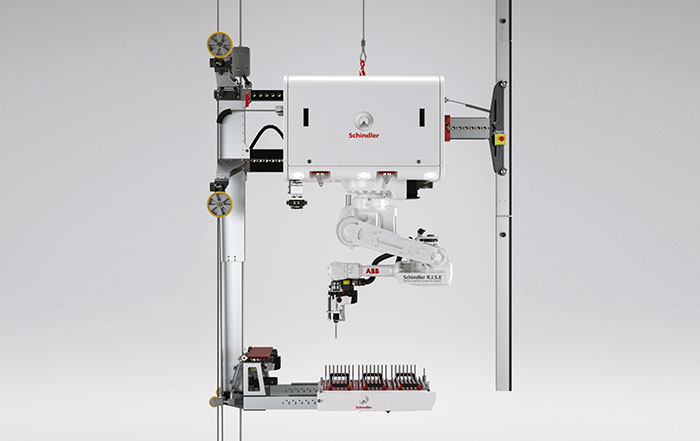The Avenue South Residences in Singapore are the world’s tallest PPVC residential towers. Learn more about how Schindler used its Robotic Installation System for Elevators.
With the central business district (CBD) to the east and the Singapore Straits beyond Sentosa Island to the south, the Avenue South Residences provides expansive views of the city and beyond. Away from the bustle of downtown, the two 56-story towers soar above their nearest neighbors. At 192 meters tall they are now the world’s tallest residential towers constructed using prefabricated prefinished volumetric construction (PPVC).
There are a lot of benefits to prefabricating the building’s modules offsite. Less dust and noise pollution and fewer people on-site makes the working environment much safer and healthier than traditional sites. For the Avenue South Residences, it also meant that during Covid the modules could be stockpiled ready to assemble. Like Lego pieces waiting in their box.
The project is also the first in Singapore to use Schindler R.I.S.E (Robotic Installation System for Elevators).
"Have you ever drilled a hole in an elevator shaft before?" asks Dominic Stutz, Schindler’s senior project manager at the Avenue South Residences. "It’s not easy! Your whole-body shakes and there 12 bolts per level."
Several years before moving to Singapore, Dominic had heard about plans to develop a robot that could drill holes when it was first discussed at Schindler. But it wasn’t until he had been assigned to the Avenue South Residences project that he read that robots were ready to do the job.
"I read a post about it and I thought this would be a perfect project to use them. We had a lot of bolts that needed drilling!"
Dominic started to make inquiries about whether it would be possible to use the technology in Singapore, to which everyone was very receptive. It was not long after that the robot, named Lea, was welcomed by an excited team. The main contractors, United Tec Construction, were happy to use the innovative technology. It was their flexibility that helped make it possible to get Lea the robot on-site. Once there even Desmond Lee, Minister of National Development of Singapore, paid a visit to see her in action.
With Lea put to work in the shafts, the installation team could work at a faster pace as they no longer had to manually drill and set the anchor bolts, a physically demanding, and time-consuming task. It also meant they had to spend less time in the shaft, which helped to improve safety.
"Schindler R.I.S.E is a perfect example of Schindler's commitment to developing smart cities of the future through advanced digital and urban mobility solutions," says Michael Li, Managing Director of Schindler Singapore. "With a rapidly growing population and a scarcity of land there is a growing need for taller buildings and faster transportation to be built. Innovations like Schindler R.I.S.E help us to accommodate such demands by achieving new levels of productivity, worker safety, and quality improvement."
Overall, ten of the Avenue South Residence’s towers elevator shafts were drilled using Schindler R.I.S.E. Dominic summed up the work by saying, "Lea did an outstanding job, not only impressing the VIPs and the local media, but also advancing safety and efficiency on the building site." For more information please visit: www.schindler.com

